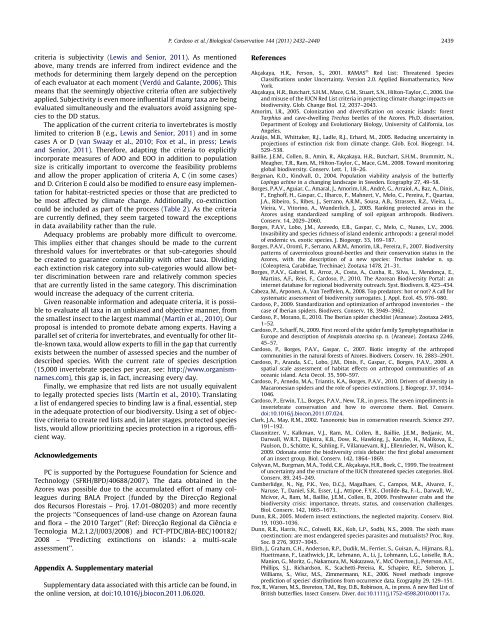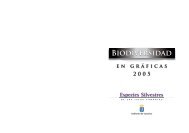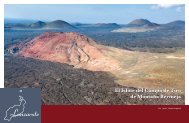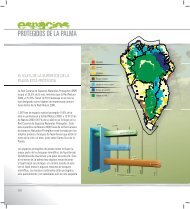Adapting the IUCN Red List criteria for invertebrates - Dr. José L ...
Adapting the IUCN Red List criteria for invertebrates - Dr. José L ...
Adapting the IUCN Red List criteria for invertebrates - Dr. José L ...
Create successful ePaper yourself
Turn your PDF publications into a flip-book with our unique Google optimized e-Paper software.
<strong>criteria</strong> is subjectivity (Lewis and Senior, 2011). As mentioned<br />
above, many trends are inferred from indirect evidence and <strong>the</strong><br />
methods <strong>for</strong> determining <strong>the</strong>m largely depend on <strong>the</strong> perception<br />
of each evaluator at each moment (Verdú and Galante, 2006). This<br />
means that <strong>the</strong> seemingly objective <strong>criteria</strong> often are subjectively<br />
applied. Subjectivity is even more influential if many taxa are being<br />
evaluated simultaneously and <strong>the</strong> evaluators avoid assigning species<br />
to <strong>the</strong> DD status.<br />
The application of <strong>the</strong> current <strong>criteria</strong> to <strong>invertebrates</strong> is mostly<br />
limited to criterion B (e.g., Lewis and Senior, 2011) and in some<br />
cases A or D (van Swaay et al., 2010; Fox et al., in press; Lewis<br />
and Senior, 2011). There<strong>for</strong>e, adapting <strong>the</strong> <strong>criteria</strong> to explicitly<br />
incorporate measures of AOO and EOO in addition to population<br />
size is critically important to overcome <strong>the</strong> feasibility problems<br />
and allow <strong>the</strong> proper application of <strong>criteria</strong> A, C (in some cases)<br />
and D. Criterion E could also be modified to ensure easy implementation<br />
<strong>for</strong> habitat-restricted species or those that are predicted to<br />
be most affected by climate change. Additionally, co-extinction<br />
could be included as part of <strong>the</strong> process (Table 2). As <strong>the</strong> <strong>criteria</strong><br />
are currently defined, <strong>the</strong>y seem targeted toward <strong>the</strong> exceptions<br />
in data availability ra<strong>the</strong>r than <strong>the</strong> rule.<br />
Adequacy problems are probably more difficult to overcome.<br />
This implies ei<strong>the</strong>r that changes should be made to <strong>the</strong> current<br />
threshold values <strong>for</strong> <strong>invertebrates</strong> or that sub-categories should<br />
be created to guarantee comparability with o<strong>the</strong>r taxa. Dividing<br />
each extinction risk category into sub-categories would allow better<br />
discrimination between rare and relatively common species<br />
that are currently listed in <strong>the</strong> same category. This discrimination<br />
would increase <strong>the</strong> adequacy of <strong>the</strong> current <strong>criteria</strong>.<br />
Given reasonable in<strong>for</strong>mation and adequate <strong>criteria</strong>, it is possible<br />
to evaluate all taxa in an unbiased and objective manner, from<br />
<strong>the</strong> smallest insect to <strong>the</strong> largest mammal (Martín et al., 2010). Our<br />
proposal is intended to promote debate among experts. Having a<br />
parallel set of <strong>criteria</strong> <strong>for</strong> <strong>invertebrates</strong>, and eventually <strong>for</strong> o<strong>the</strong>r little-known<br />
taxa, would allow experts to fill in <strong>the</strong> gap that currently<br />
exists between <strong>the</strong> number of assessed species and <strong>the</strong> number of<br />
described species. With <strong>the</strong> current rate of species description<br />
(15,000 invertebrate species per year, see: http://www.organismnames.com),<br />
this gap is, in fact, increasing every day.<br />
Finally, we emphasize that red lists are not usually equivalent<br />
to legally protected species lists (Martín et al., 2010). Translating<br />
a list of endangered species to binding law is a final, essential, step<br />
in <strong>the</strong> adequate protection of our biodiversity. Using a set of objective<br />
<strong>criteria</strong> to create red lists and, in later stages, protected species<br />
lists, would allow prioritizing species protection in a rigorous, efficient<br />
way.<br />
Acknowledgements<br />
PC is supported by <strong>the</strong> Portuguese Foundation <strong>for</strong> Science and<br />
Technology (SFRH/BPD/40688/2007). The data obtained in <strong>the</strong><br />
Azores was possible due to <strong>the</strong> accumulated ef<strong>for</strong>t of many colleagues<br />
during BALA Project (funded by <strong>the</strong> Direcção Regional<br />
dos Recursos Florestais – Proj. 17.01-080203) and more recently<br />
<strong>the</strong> projects ‘‘Consequences of land-use change on Azorean fauna<br />
and flora – <strong>the</strong> 2010 Target’’ (Ref: Direcção Regional da Ciência e<br />
Tecnologia M.2.1.2/I/003/2008) and FCT-PTDC/BIA-BEC/100182/<br />
2008 – ‘‘Predicting extinctions on islands: a multi-scale<br />
assessment’’.<br />
Appendix A. Supplementary material<br />
Supplementary data associated with this article can be found, in<br />
<strong>the</strong> online version, at doi:10.1016/j.biocon.2011.06.020.<br />
P. Cardoso et al. / Biological Conservation 144 (2011) 2432–2440 2439<br />
References<br />
Akçakaya, H.R., Ferson, S., 2001. RAMAS Ò <strong>Red</strong> <strong>List</strong>: Threatened Species<br />
Classifications under Uncertainty. Version 2.0. Applied Bioma<strong>the</strong>matics, New<br />
York.<br />
Akçakaya, H.R., Butchart, S.H.M., Mace, G.M., Stuart, S.N., Hilton-Taylor, C., 2006. Use<br />
and misuse of <strong>the</strong> <strong>IUCN</strong> <strong>Red</strong> <strong>List</strong> <strong>criteria</strong> in projecting climate change impacts on<br />
biodiversity. Glob. Change Biol. 12, 2037–2043.<br />
Amorim, I.R., 2005. Colonization and diversification on oceanic islands: <strong>for</strong>est<br />
Tarphius and cave-dwelling Trechus beetles of <strong>the</strong> Azores. Ph.D. dissertation,<br />
Department of Ecology and Evolutionary Biology, University of Cali<strong>for</strong>nia, Los<br />
Angeles.<br />
Araújo, M.B., Whittaker, R.J., Ladle, R.J., Erhard, M., 2005. <strong>Red</strong>ucing uncertainty in<br />
projections of extinction risk from climate change. Glob. Ecol. Biogeogr. 14,<br />
529–538.<br />
Baillie, J.E.M., Collen, B., Amin, R., Akçakaya, H.R., Butchart, S.H.M., Brummitt, N.,<br />
Meagher, T.R., Ram, M., Hilton-Taylor, C., Mace, G.M., 2008. Toward monitoring<br />
global biodiversity. Conserv. Lett. 1, 18–26.<br />
Bergman, K.O., Kindvall, O., 2004. Population viability analysis of <strong>the</strong> butterfly<br />
Lopinga achine in a changing landscape in Sweden. Ecography 27, 49–58.<br />
Borges, P.A.V., Aguiar, C., Amaral, J., Amorim, I.R., André, G., Arraiol, A., Baz, A., Dinis,<br />
F., Enghoff, H., Gaspar, C., Ilharco, F., Mahnert, V., Melo, C., Pereira, F., Quartau,<br />
J.A., Ribeiro, S., Ribes, J., Serrano, A.R.M., Sousa, A.B., Strassen, R.Z., Vieira, L.,<br />
Vieira, V., Vitorino, A., Wunderlich, J., 2005. Ranking protected areas in <strong>the</strong><br />
Azores using standardized sampling of soil epigean arthropods. Biodivers.<br />
Conserv. 14, 2029–2060.<br />
Borges, P.A.V., Lobo, J.M., Azevedo, E.B., Gaspar, C., Melo, C., Nunes, L.V., 2006.<br />
Invasibility and species richness of island endemic arthropods: a general model<br />
of endemic vs. exotic species. J. Biogeogr. 33, 169–187.<br />
Borges, P.A.V., Oromí, P., Serrano, A.R.M., Amorim, I.R., Pereira, F., 2007. Biodiversity<br />
patterns of cavernicolous ground-beetles and <strong>the</strong>ir conservation status in <strong>the</strong><br />
Azores, with <strong>the</strong> description of a new species: Trechus isabelae n. sp.<br />
(Coleoptera, Carabidae, Trechinae). Zootaxa 1478, 21–31.<br />
Borges, P.A.V., Gabriel, R., Arroz, A., Costa, A., Cunha, R., Silva, L., Mendonça, E.,<br />
Martins, A.F., Reis, F., Cardoso, P., 2010. The Azorean Biodiversity Portal: an<br />
internet database <strong>for</strong> regional biodiversity outreach. Syst. Biodivers. 8, 423–434.<br />
Cabeza, M., Arponen, A., Van Teeffelen, A., 2008. Top predators: hot or not? A call <strong>for</strong><br />
systematic assessment of biodiversity surrogates. J. Appl. Ecol. 45, 976–980.<br />
Cardoso, P., 2009. Standardization and optimization of arthropod inventories – <strong>the</strong><br />
case of Iberian spiders. Biodivers. Conserv. 18, 3949–3962.<br />
Cardoso, P., Morano, E., 2010. The Iberian spider checklist (Araneae). Zootaxa 2495,<br />
1–52.<br />
Cardoso, P., Scharff, N., 2009. First record of <strong>the</strong> spider family Symphytognathidae in<br />
Europe and description of Anapistula ataecina sp. n. (Araneae). Zootaxa 2246,<br />
45–57.<br />
Cardoso, P., Borges, P.A.V., Gaspar, C., 2007. Biotic integrity of <strong>the</strong> arthropod<br />
communities in <strong>the</strong> natural <strong>for</strong>ests of Azores. Biodivers. Conserv. 16, 2883–2901.<br />
Cardoso, P., Aranda, S.C., Lobo, J.M., Dinis, F., Gaspar, C., Borges, P.A.V., 2009. A<br />
spatial scale assessment of habitat effects on arthropod communities of an<br />
oceanic island. Acta Oecol. 35, 590–597.<br />
Cardoso, P., Arnedo, M.A., Triantis, K.A., Borges, P.A.V., 2010. <strong>Dr</strong>ivers of diversity in<br />
Macaronesian spiders and <strong>the</strong> role of species extinctions. J. Biogeogr. 37, 1034–<br />
1046.<br />
Cardoso, P., Erwin, T.L., Borges, P.A.V., New, T.R., in press. The seven impediments in<br />
invertebrate conservation and how to overcome <strong>the</strong>m. Biol. Conserv.<br />
doi:10.1016/j.biocon.2011.07.024.<br />
Clark, J.A., May, R.M., 2002. Taxonomic bias in conservation research. Science 297,<br />
191–192.<br />
Clausnitzer, V., Kalkman, V.J., Ram, M., Collen, B., Baillie, J.E.M., Bedjanic, M.,<br />
Darwall, W.R.T., Dijkstra, K.B., Dow, R., Hawking, J., Karube, H., Malikova, E.,<br />
Paulson, D., Schütte, K., Suhling, F., Villanuevam, R.J., Ellenrieder, N., Wilson, K.,<br />
2009. Odonata enter <strong>the</strong> biodiversity crisis debate: <strong>the</strong> first global assessment<br />
of an insect group. Biol. Conserv. 142, 1864–1869.<br />
Colyvan, M., Burgman, M.A., Todd, C.R., Akçakaya, H.R., Boek, C., 1999. The treatment<br />
of uncertainty and <strong>the</strong> structure of <strong>the</strong> <strong>IUCN</strong> threatened species categories. Biol.<br />
Conserv. 89, 245–249.<br />
Cumberlidge, N., Ng, P.K., Yeo, D.C.J., Magalhaes, C., Campos, M.R., Alvarez, F.,<br />
Naruse, T., Daniel, S.R., Esser, L.J., Attipoe, F.Y.K., Clotilde-Ba, F.-L., Darwall, W.,<br />
Mcivor, A., Ram, M., Baillie, J.E.M., Collen, B., 2009. Freshwater crabs and <strong>the</strong><br />
biodiversity crisis: importance, threats, status, and conservation challenges.<br />
Biol. Conserv. 142, 1665–1673.<br />
Dunn, R.R., 2005. Modern insect extinctions, <strong>the</strong> neglected majority. Conserv. Biol.<br />
19, 1030–1036.<br />
Dunn, R.R., Harris, N.C., Colwell, R.K., Koh, L.P., Sodhi, N.S., 2009. The sixth mass<br />
coextinction: are most endangered species parasites and mutualists? Proc. Roy.<br />
Soc. B 276, 3037–3045.<br />
Elith, J., Graham, C.H., Anderson, R.P., Dudik, M., Ferrier, S., Guisan, A., Hijmans, R.J.,<br />
Huettmann, F., Leathwick, J.R., Lehmann, A., Li, J., Lohmann, L.G., Loiselle, B.A.,<br />
Manion, G., Moritz, G., Nakamura, M., Nakazawa, Y., McC Overton, J., Peterson, A.T.,<br />
Phillips, S.J., Richardson, K., Scachetti-Pereira, R., Schapire, R.E., Soberon, J.,<br />
Williams, S., Wisz, M.S., Zimmermann, N.E., 2006. Novel methods improve<br />
prediction of species’ distributions from occurrence data. Ecography 29, 129–151.<br />
Fox, R., Warren, M.S., Brereton, T.M., Roy, D.B., Robinson, A., in press. A new <strong>Red</strong> <strong>List</strong> of<br />
British butterflies. Insect Conserv. Diver. doi:10.1111/j.1752-4598.2010.00117.x.





